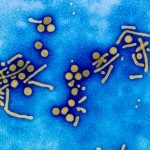Link to Pubmed [PMID] – 15221536
Arch. Virol. 2004 Jul;149(7):1353-71
Hepatitis C virus infection (HCV), is a major cause of liver disease worldwide, and are frequently resistant to the interferon alpha treatment. The nonstructural (NS) 5A protein of HCV has been proposed to be involved in this resistance. Additional studies have pointed out a role for NS5A in several other cellular interactions as well as an important role of its adaptative mutations in HCV genome replication. However, no infectious system is available to assess the role of NS5A in the HCV life cycle. Thus, we have constructed a recombinant system directly demonstrating for the first time that the expression of NS5A confers a multiplicative advantage to Sindbis virus, a virus close to HCV. This advantage seemed to be related to an anti-apoptotic effect of the NS5A protein. At a later stage, a possible nuclear localization of NS5A was observed, likely due to apoptotic cleavages of this protein. The NS5A protein was also shown to induce the interleukin-8 (IL-8) mRNA and to activate the NF-kappaB pathway independently of the Sindbis virus. Together, our data suggest that the activation of NF-kappaB could lead to the anti-apoptotic activity of NS5A and explain the viral multiplicative advantage conferred by the expression of the NS5A protein.
